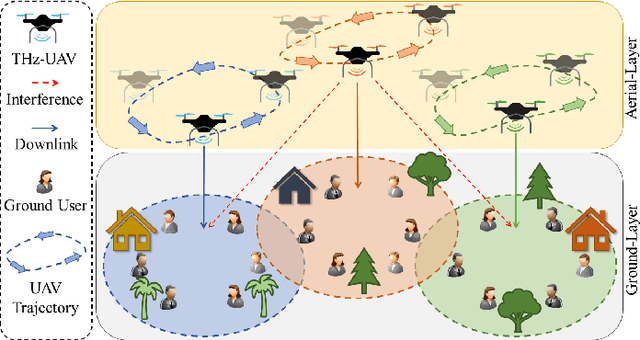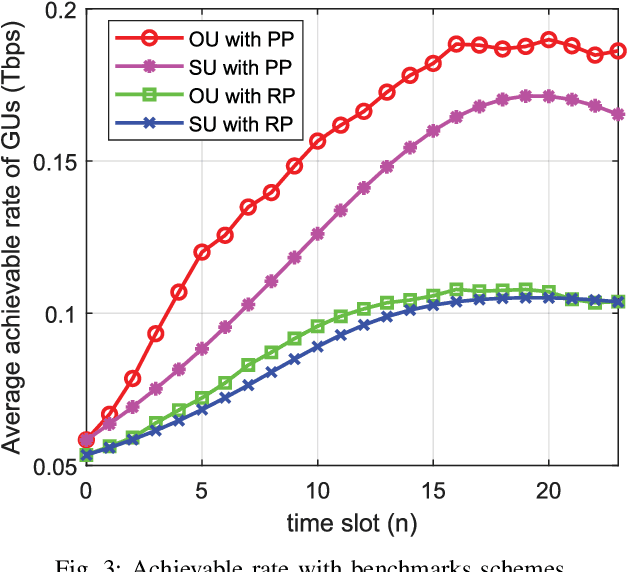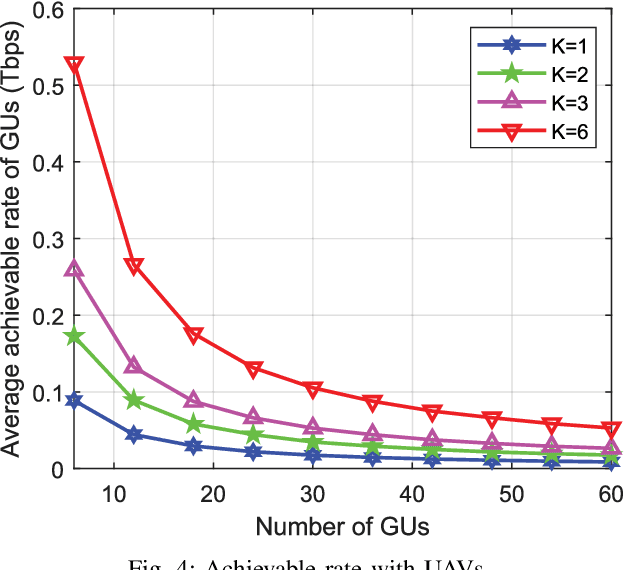Sheikh Salman Hassan
Enhancing Spectrum Efficiency in 6G Satellite Networks: A GAIL-Powered Policy Learning via Asynchronous Federated Inverse Reinforcement Learning
Sep 27, 2024Abstract:In this paper, a novel generative adversarial imitation learning (GAIL)-powered policy learning approach is proposed for optimizing beamforming, spectrum allocation, and remote user equipment (RUE) association in NTNs. Traditional reinforcement learning (RL) methods for wireless network optimization often rely on manually designed reward functions, which can require extensive parameter tuning. To overcome these limitations, we employ inverse RL (IRL), specifically leveraging the GAIL framework, to automatically learn reward functions without manual design. We augment this framework with an asynchronous federated learning approach, enabling decentralized multi-satellite systems to collaboratively derive optimal policies. The proposed method aims to maximize spectrum efficiency (SE) while meeting minimum information rate requirements for RUEs. To address the non-convex, NP-hard nature of this problem, we combine the many-to-one matching theory with a multi-agent asynchronous federated IRL (MA-AFIRL) framework. This allows agents to learn through asynchronous environmental interactions, improving training efficiency and scalability. The expert policy is generated using the Whale optimization algorithm (WOA), providing data to train the automatic reward function within GAIL. Simulation results show that the proposed MA-AFIRL method outperforms traditional RL approaches, achieving a $14.6\%$ improvement in convergence and reward value. The novel GAIL-driven policy learning establishes a novel benchmark for 6G NTN optimization.
Semantic Enabled 6G LEO Satellite Communication for Earth Observation: A Resource-Constrained Network Optimization
Jul 31, 2024



Abstract:Earth observation satellites generate large amounts of real-time data for monitoring and managing time-critical events such as disaster relief missions. This presents a major challenge for satellite-to-ground communications operating under limited bandwidth capacities. This paper explores semantic communication (SC) as a potential alternative to traditional communication methods. The rationality for adopting SC is its inherent ability to reduce communication costs and make spectrum efficient for 6G non-terrestrial networks (6G-NTNs). We focus on the critical satellite imagery downlink communications latency optimization for Earth observation through SC techniques. We formulate the latency minimization problem with SC quality-of-service (SC-QoS) constraints and address this problem with a meta-heuristic discrete whale optimization algorithm (DWOA) and a one-to-one matching game. The proposed approach for captured image processing and transmission includes the integration of joint semantic and channel encoding to ensure downlink sum-rate optimization and latency minimization. Empirical results from experiments demonstrate the efficiency of the proposed framework for latency optimization while preserving high-quality data transmission when compared to baselines.
Design Optimization of NOMA Aided Multi-STAR-RIS for Indoor Environments: A Convex Approximation Imitated Reinforcement Learning Approach
Jun 19, 2024



Abstract:Sixth-generation (6G) networks leverage simultaneously transmitting and reflecting reconfigurable intelligent surfaces (STAR-RISs) to overcome the limitations of traditional RISs. STAR-RISs offer 360-degree full-space coverage and optimized transmission and reflection for enhanced network performance and dynamic control of the indoor propagation environment. However, deploying STAR-RISs indoors presents challenges in interference mitigation, power consumption, and real-time configuration. In this work, a novel network architecture utilizing multiple access points (APs) and STAR-RISs is proposed for indoor communication. An optimization problem encompassing user assignment, access point beamforming, and STAR-RIS phase control for reflection and transmission is formulated. The inherent complexity of the formulated problem necessitates a decomposition approach for an efficient solution. This involves tackling different sub-problems with specialized techniques: a many-to-one matching algorithm is employed to assign users to appropriate access points, optimizing resource allocation. To facilitate efficient resource management, access points are grouped using a correlation-based K-means clustering algorithm. Multi-agent deep reinforcement learning (MADRL) is leveraged to optimize the control of the STAR-RIS. Within the proposed MADRL framework, a novel approach is introduced where each decision variable acts as an independent agent, enabling collaborative learning and decision-making. Additionally, the proposed MADRL approach incorporates convex approximation (CA). This technique utilizes suboptimal solutions from successive convex approximation (SCA) to accelerate policy learning for the agents, thereby leading to faster environment adaptation and convergence. Simulations demonstrate significant network utility improvements compared to baseline approaches.
SpaceRIS: LEO Satellite Coverage Maximization in 6G Sub-THz Networks by MAPPO DRL and Whale Optimization
Jul 28, 2023Abstract:Satellite systems face a significant challenge in effectively utilizing limited communication resources to meet the demands of ground network traffic, characterized by asymmetrical spatial distribution and time-varying characteristics. Moreover, the coverage range and signal transmission distance of low Earth orbit (LEO) satellites are restricted by notable propagation attenuation, molecular absorption, and space losses in sub-terahertz (THz) frequencies. This paper introduces a novel approach to maximize LEO satellite coverage by leveraging reconfigurable intelligent surfaces (RISs) within 6G sub-THz networks. The optimization objectives encompass enhancing the end-to-end data rate, optimizing satellite-remote user equipment (RUE) associations, data packet routing within satellite constellations, RIS phase shift, and ground base station (GBS) transmit power (i.e., active beamforming). The formulated joint optimization problem poses significant challenges owing to its time-varying environment, non-convex characteristics, and NP-hard complexity. To address these challenges, we propose a block coordinate descent (BCD) algorithm that integrates balanced K-means clustering, multi-agent proximal policy optimization (MAPPO) deep reinforcement learning (DRL), and whale optimization (WOA) techniques. The performance of the proposed approach is demonstrated through comprehensive simulation results, exhibiting its superiority over existing baseline methods in the literature.
3TO: THz-Enabled Throughput and Trajectory Optimization of UAVs in 6G Networks by Proximal Policy Optimization Deep Reinforcement Learning
Feb 07, 2022



Abstract:Next-generation networks need to meet ubiquitous and high data-rate demand. Therefore, this paper considers the throughput and trajectory optimization of terahertz (THz)-enabled unmanned aerial vehicles (UAVs) in the sixth-generation (6G) communication networks. In the considered scenario, multiple UAVs must provide on-demand terabits per second (TB/s) services to an urban area along with existing terrestrial networks. However, THz-empowered UAVs pose some new constraints, e.g., dynamic THz-channel conditions for ground users (GUs) association and UAV trajectory optimization to fulfill GU's throughput demands. Thus, a framework is proposed to address these challenges, where a joint UAVs-GUs association, transmit power, and the trajectory optimization problem is studied. The formulated problem is mixed-integer non-linear programming (MINLP), which is NP-hard to solve. Consequently, an iterative algorithm is proposed to solve three sub-problems iteratively, i.e., UAVs-GUs association, transmit power, and trajectory optimization. Simulation results demonstrate that the proposed algorithm increased the throughput by up to 10%, 68.9%, and 69.1% respectively compared to baseline algorithms.
Blue Data Computation Maximization in 6G Space-Air-Sea Non-Terrestrial Networks
Feb 05, 2022Abstract:Non-terrestrial networks (NTN), encompassing space and air platforms, are a key component of the upcoming sixth-generation (6G) cellular network. Meanwhile, maritime network traffic has grown significantly in recent years due to sea transportation used for national defense, research, recreational activities, domestic and international trade. In this paper, the seamless and reliable demand for communication and computation in maritime wireless networks is investigated. Two types of marine user equipment (UEs), i.e., low-antenna gain and high-antenna gain UEs, are considered. A joint task computation and time allocation problem for weighted sum-rate maximization is formulated as mixed-integer linear programming (MILP). The goal is to design an algorithm that enables the network to efficiently provide backhaul resources to an unmanned aerial vehicle (UAV) and offload HUEs tasks to LEO satellite for blue data (i.e., marine user's data). To solve this MILP, a solution based on the Bender and primal decomposition is proposed. The Bender decomposes MILP into the master problem for binary task decision and subproblem for continuous-time resource allocation. Moreover, primal decomposition deals with a coupling constraint in the subproblem. Finally, numerical results demonstrate that the proposed algorithm provides the maritime UEs coverage demand in polynomial time computational complexity and achieves a near-optimal solution.
 Add to Chrome
Add to Chrome Add to Firefox
Add to Firefox Add to Edge
Add to Edge